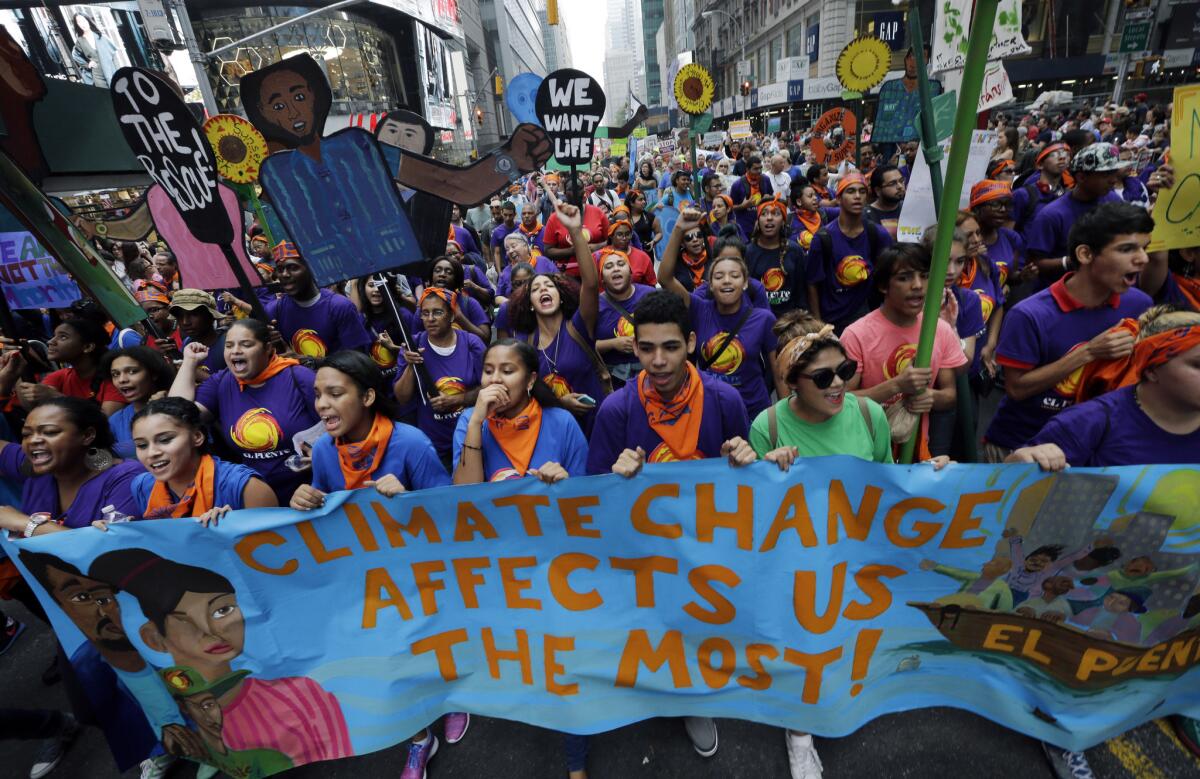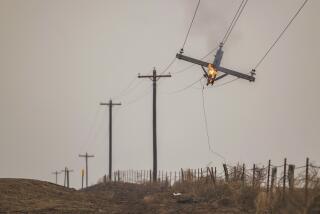Few U.S. states preparing for climate change, study says

- Share via
Reporting from Washington — Fewer than half of American states are working to protect themselves from climate change, despite more detailed warnings from scientists that communities are already being damaged, according to a new online clearinghouse of states’ efforts compiled by the Georgetown Climate Center.
Fourteen states have plans to prepare for the effects of climate change. California, New York and Maryland are among those that have made the greatest progress toward the dozens of goals their plans set forth, such as cutting statewide greenhouse gas emissions, improving infrastructure, securing water supplies, battling wildfires or coping with rising sea levels. Even those states have much work ahead of them, though.
Another eight states and the District of Columbia are devising similar plans, and some counties and towns have plans in place, too. But more than half of American states have not taken any steps to address the threats posed by climate change, leaving them vulnerable to predicted flooding, drought and wildfire, and leaving taxpayers on the hook for the cleanup.
The online tool is meant to give communities a way to track what their state is doing to adapt to climate change. Lawmakers and regulators could also use the tool to glean ideas from states that are further along.
Vicki Arroyo, director of the Georgetown Climate Center in Washington, said she welcomed the progress that a “significant minority” of states have made on planning, but acknowledged that in much of the country, the work to deal with climate change has yet to begin.
“A number of states have started implementing changes that will actually make their communities more resilient. That’s good news,” Arroyo said. “Unfortunately, the research also shows that many states are still not treating this issue with the urgency that is called for.”
In May, the congressionally mandated Third National Climate Assessment sketched out sobering scenarios of global warming’s impact on different regions of the United States. The Northeast and Midwest, for instance, would see a huge increase in heavy downpours that could lead to flooding and erosion. The Southwest, including California, would be more prone to extreme heat, drought and wildfire.
Other agencies, such as the U.S. Geological Survey, have shown that coastal communities in Oregon, California, the mid-Atlantic, eastern Florida and the Gulf Coast are highly vulnerable to damage from rising sea levels.
The states furthest along in their plans are those on the West Coast, including Alaska and Hawaii, in the Northeast, Mid-Atlantic and Florida. Away from the coasts, only Colorado has a plan finalized. Minnesota, Wisconsin and Michigan are in various stages of planning for climate change. Illinois has no plan, although Chicago does.
The inaction throughout much of the country was the “unfortunate side effect” of the political polarization of climate change over the last decade, said Greg Dotson, vice president for energy policy at the Center for American Progress, a progressive think tank.
“People don’t want to acknowledge that there’s a problem with unavoidable consequences that you have to plan for,” he said.
Laggard states might soon be prodded to act thanks to an update in July to federal policies. States are now required to factor climate change into their disaster planning or risk losing an increased share of federal money the next time a natural disaster occurs.
Even in states that lack plans, individual communities are pushing ahead, the Georgetown website shows. The city of Waveland, Miss., terribly damaged by Hurricane Katrina, is planning for future damage that higher sea levels, storm surges and flooding could bring. Tucson is planning for the effects of long-term drought on its water resources. Salt Lake City is also working to preserve its water resources and factoring in climate change as it selects trees to add to the city’s tree canopy.
Still, those states that rolled out plans years ago are not far along in their work, according to the website.
California offers incentives to municipalities to integrate climate change in planning their water usage, for example. But the state has not mandated such planning, in part because midsize and small communities lack the expertise and data to determine just how hard climate change will hit them, said Jessica Grannis, adaptation program manager for the Georgetown Climate Center.
Such challenges have slowed preparation for climate change in other states, too, Arroyo said. This year, the Obama administration pledged to roll out data tools and apps that would help communities gather the information they needed to plan for future disasters.
The online tool is based on publicly available information for each state and on interviews with officials from the 14 states that have plans.
Twitter: @neelaeast
More to Read
Sign up for Essential California
The most important California stories and recommendations in your inbox every morning.
You may occasionally receive promotional content from the Los Angeles Times.











